What are Dodge HEMI Active Exhaust Valves? What do they do? How do they work?

Hemi Dodge Challengers and Chargers Get Dual Mode Exhaust
With the overwhelming popularity of the dual mode exhaust systems on the 2015-2016 Dodge Challenger SRT Hellcat and the Dodge Charger R/T Scat Pack, Dodge made the decision to offer a loud dual mode exhaust system standard on 2017 (and later) Dodge Chargers and Challengers equipped with a Hemi V8 engine.
When those 2017 models were introduced in the Hellcat and Scat Pack trimlines, they came loaded with a 2.75-inch dual mode exhaust system that let the Hemi engines howl when pushed, while still quieting down in more gentle driving situations. The advantage to this active exhaust system is that it allows you to let that high-performance engine scream when it is opened up, but still not bother the neighbors when you are warming the car up before going to work.
Second only to horsepower, the sound of these dual mode "scat pack exhaust systems" on the 2015-2016 Dodge Challenger and Charger Scat Pack and Hellcat were a favorites feature for owners. This, however, left owners of the models sporting the 5.7L Hemi V8 engine to look for aftermarket exhaust components to get a similar scat pack exhaust sound. In 2017, that changed. That's when every Dodge Challenger and Charger with a Hemi engine came equipped with the 2.75-inch dual mode exhaust system.
Dual Mode Exhaust for All Hemi Muscle Cars
This means, starting with the 2017 model year, the Challenger in R/T, R/T Plus, R/T Shaker and R/T Shaker Plus trimlines, and the Charger in R/T and R/T Road & Track trimlines are equipped with the same growling exhaust system as the Scat Pack and Hellcat models.
How the Dual Mode Exhaust System Works
The dual mode exhaust system in each Hemi-equipped Dodge Challenger and Charger is what is known as an "active exhaust." If you are asking, "What is an active exhaust," it's best to answer by explaining how and active exhaust works. The Dodge dual-mode exhaust system employs a pair of electronic valves situated toward the rear of the vehicle. The valves in this active exhaust system are in place to control the output of the exhaust noise and are closed to keep sound levels at a minimum when the engine is idling and/or in light throttle situations. The setting also assists in minimizing the "drone" sound during highway driving. When you put the pedal to the metal, though, those valves open up and the exhaust starts to roar.
In recent years, a lot of car manufacturers cleverly responded by programming deliberate dead-spots into the ECUs of their cars at the particular load/speed points at which cars were tested for decibel loudness, while allowing them more volume everywhere else.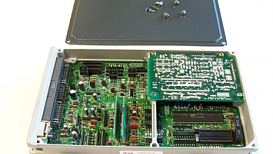
Today, car manufacturers have come up a better solution to the exhaust noise problem- active exhausts. An active exhaust consists of a “flapper” valve that opens up when the driver requires high revs, more response and big power. It bypasses the more restrictive elements of the exhaust. The restrictive elements stay in play and keep the volume down while running the kids to school or quietly cruising around. The FPV GT uses a vacuum system where the throttle body pulls the flapper valve open. Other cars, like modern Audis, use a push button on the dash that electrically opens or closes the valve.
The active exhaust provides a simple, elegant solution to getting around the regulations on car noise, while allowing the cars to retain their distinctive exhaust note characters and power production when the need arises.
Dodge uses active exhaust valves to reduce exhaust noise in its big 6.2 and 6.4L Hemis in order to meet and pass EPA noise regulations.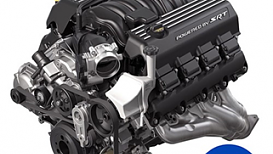
The active exhaust valves consist of two parts. First is the mechanical butterfly valves that are welded into the exhaust pipe on each bank.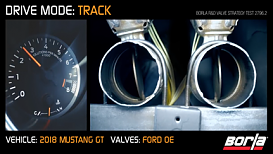
Mounted to each of these is a smart electric actuator which has a power, ground and bus feedback wire. They are connected to the mechanical valves through a transmission spring. The spring is used to help reduce heat from transferring between the mechanical butterfly valves and the actuators.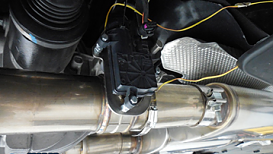
(Note- Due to premature breakage of the first generation of spring released, Dodge made a change to this spring beginning around 7/2015. The tightly wound flat spring (see image on right) was replaced by a more robust second generation spring (see image on left). The newer design was to put more air space between the coils to keep the spring cool and prevent breakage when attached to the hot OEM exhaust valve).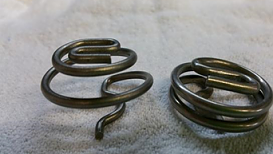
The Active Exhaust Valve actuators communicate with the Powertrain Control Module (PCM) over a LIN Bus circuit. The actuators have three wires- positive, ground and BUS (data). Positions are communicated via computer language between the PCM and the actuator itself. The actuator has a microprocessor that communicates over the BUS wire with the PCM and vice versa. It's much more complicated than a simple switch or potentiometer. The actuator looks for a language command over the BUS to open or close.
The Active Exhaust Valve actuator 1 (left) and Active Exhaust Valve actuator 2 (right) each has a unique part number/internal ID. The PCM can identify each actuator location by this unique ID. The PCM sends a position command to the Active Exhaust Valve actuators based on engine torque, rpm and vehicle speed. The Active Exhaust Valve actuators move the butterfly valves to the commanded position. An internal Hall Effect sensor counts the pulses and determines valve position. The valve actuators are calibrated at every Key-ON event. The PCM sends full open and full closed commands and checks actual against commanded position. If for any reason the calibration is unsuccessful, the actuators are self-diagnosing and report fault flags to the PCM over the LIN Bus.
If the valve position doesn’t match a predetermined calibration, a performance code is set and the valves will default to the full open position. If an actuator is not attached to the mechanical valve, or the transmission spring is broken or missing, the actuator will continue to rotate indefinitely and set a fault. Also, if the mechanical valve is stuck and will not move, a fault will set.
NOTE: There is a crossover in the exhaust, upstream of the valves that will allow the exhaust to flow through the open valve in the event one of the valves is stuck closed.
NOTE: If the transmission spring breaks or the valve becomes disconnected from the actuator for whatever reason the valve assembly likely will cause a rattling noise with the engine running.
There are 4 possible diagnostic trouble codes involving active exhaust valves:
P1217-ACTIVE EXHAUST VALVE 1 PERFORMANCE
P121B-ACTIVE EXHAUST VALVE 2 PERFORMANCE
U142B-IMPLAUSIBLE DATA RECEIVED FROM EXHAUST VALVE 1
U142C-IMPLAUSIBLE DATA RECEIVED FROM EXHAUST VALVE 2


Leave a comment